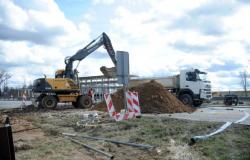The public often talks about air pollution caused by cars in cities, but it is rarely taken into account that, for example, a large container ship can produce as much pollution as millions of cars. Therefore, reducing emissions from maritime transport is very important in the fight against pollution and climate change. This is the goal aimed at by all the world’s most developed ports, including the ports of the Baltic States, where several modern, environmentally friendly solutions have already been introduced in recent years.
“Green port” concept
About 90 percent of world trade is carried out by sea. Every year, billions of tons of goods are transported by sea, from crude oil and gas to food and cars. Emissions from international shipping have risen to around 858 million tonnes of carbon dioxide (MtCO₂). Ships pollute the environment not only when they carry goods or passengers, but also when they are docked in ports, because the electrical and other systems installed on board must work continuously. And most ships still use fossil fuels to generate electricity. For example, a large container ship docked in a port consumes as much as 5-10 MW of electricity – about the same as a large factory.
The ports of the European Union must develop infrastructure and provide ships with shore power until 2030.
The manager of the Freeport of Riga, Ansis Zeltiņš, says that in the near future it is planned to start the implementation of several climate-neutral projects in the port of Riga, including the creation of environmentally friendly refueling and ship electric charging infrastructure, as well as work on the modernization of the ship fleet of the port of Riga, introducing technologies for the use of renewable energy resources. reducing fossil fuel emissions and thus contributing to the achievement of climate neutrality and decarbonisation goals.
Tallinn, the pioneer, was soon followed by Riga and Klaipeda
The port of Tallinn has installed shore echo sounders in five berths in the city center, in the Old Town port, which already from 2019-2020 serve liners plying between Tallinn, Helsinki and Stockholm.
A memorandum of understanding with the ports of Helsinki, Turku and Stockholm, which agreed on general principles and standards, facilitated faster action. According to Sirle Arro, the head of the Marketing and Communication Department of the Port of Tallinn, a study is currently being conducted to find the best solution for shore electrical connection of container ships in the port of Mūga. And in the near future, the port of Tallinn plans to provide shore power connections for cruise ship berths in the port of Vantaa. “It is important to point out that shore-based electricity alone is not enough to reduce CO2 emissions. Emissions will only decrease if ships connected to the shore power grid also use electricity produced from renewable energy sources,” says Sirle Arro.
Several shore electricity connection stations have also been built in the port of Riga. As Ansis Zeltiņš informed, work is currently underway on the new passenger terminal project, the infrastructure of which will also provide electricity connection to the shore. However, Europe is currently facing challenges in the efficient use of coastal connections. “They have been installed in several ports, but many of them are not being used efficiently, mainly due to differences in the price of electricity. Currently, the regulation does not make it mandatory for ships to take electricity from a shore station, which means that ships are free to choose whether to run the ship’s diesel-electric equipment or pay for electricity from the shore, and therefore, if the electricity produced on the ship is cheaper, this is often the basis of the choice,” says Ansis Zeltiņš.
Electricity supply infrastructure for ships in the port of Klaipėda will be available from 2026
For the time being, the large ships arriving at Klaipėda port do not have the opportunity to connect to the electricity connections at the piers. However, as part of its commitment to sustainability, the Port of Klaipėda has adopted the “Green Port” concept and will soon launch a number of ambitious projects.
The electricity supply infrastructure for ro-ro ships in the port of Klaipėda will be ready for use in 2026, and in the future it will also be available for container ships and cruise ships. Shore power connections will allow ships in port to turn off their auxiliary engines and receive power from shore.
At the end of 2026, it is planned to start producing green hydrogen from renewable energy sources in the port of Klaipeda. This energy will be used not only for ships, but also for public and private transport. In 2024, the port of Klaipėda plans to purchase a renewable electricity generation station, the electricity of which will be used for the production of hydrogen and for the needs of the port administration.
The Port of Riga is also actively working towards several renewable energy initiatives, including the Port of Riga is a member of the Latvian Water Harvesting Association and, since last year, also one of the partners in the BalticSeaH2 project of the cross-border hydrogen valley. The aim of the project is to bring together international partners from many European countries and create the first and the largest cross-border hydrogen valley in the region.
Port modernization challenges – electricity distribution and investments
Andrjus Šablinskas, doctor of energy sciences, head of the sales team of the international energy management company “Schneider Electric” in Lithuania, says that the electrification of the Baltic ports has started successfully.
He notes that very significant changes in energy efficiency in industry, infrastructure companies and commercial buildings were affected by the increase in energy prices in 2022. “If this had not happened, not much would have been done. Companies saw high electricity prices in 2022 as one of the main threats and made investments. Along with the drop in electricity and gas prices, investments in energy efficiency have slowed down,” notes A. Šablinskas, adding that the price fluctuations will continue in the future, so we should continue what we have started.
The expert believes that electrification and other sustainability-related solutions will be driven by increasing regulatory requirements and increasing taxes on CO2 emissions.
Ports in Scandinavian countries such as Sweden and Norway have very high emission requirements and advanced electrification solutions have been in place for a long time. Andrjus Šablinskas was involved in the project in which “Schneider Electric” installed shore power supply infrastructure for ships in Bergen in 2015.
The international energy management company “Schneider Electric” is part of the maritime cluster, and its experts have analyzed the challenges of the electrification of the Baltic ports.
“There should be no problems with the production of electricity in the process of port electrification. Large wind farms will be built in the Baltic Sea in Lithuania and Estonia. However, there will be challenges and significant investments will be needed to distribute this electricity and deliver it to end users in the port, because, for example, the electrification of the Klaipėda port quays will require a lot of additional power, according to our estimates, several hundred megawatts,” explains A. Šablinskas.
Tags: electrification solutions reduce pollution ports Baltic Sea
-





